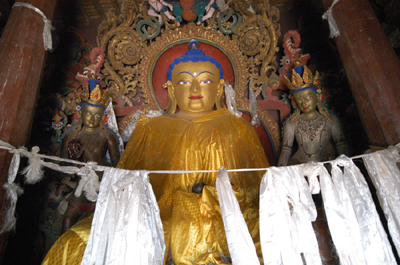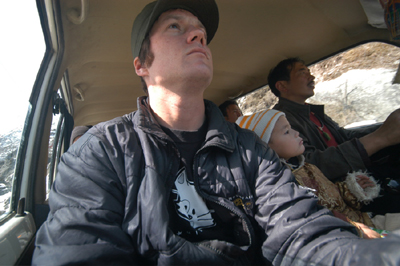|

Compassion Buddha at the Gyanste Monastery
From the Chengdu Gonzo Field Office
(continued)
By Freeman Anthony
Our guide, Tesring, gives a quick, broken English summary of the monastery's
history, noting each statue as we pass. He mentions Teaching Buddha,
Future Buddha, Compassion Buddha, Tsongkapa, and others, but I lack
the mental capacity to remember anything but the Compassion Buddha,
an 8-meter-high (about 26 feet) figure. I commune for a brief eternity
with this guy from below. His serene gaze, from blue, red and white
eyes, is calm as a glassy lake at dawn, deep and full of the purest
intent, knowledge, and love.
I'm reminded of how, in a Kathmandu guesthouse shop, I'd bought a little
companion for my trip. The old man at the counter had placed seven small
green Buddhas in a row, naming each one. I chose to honor the displaced
Dalai Lama, considered the earthly reincarnation of the Compassion Buddha.
I leave a one yuan contribution on a stack of sunflower seeds in a
rough gold urn and nod to the monk as I exit. He nods back with a smile
that says he is at peace with his approach to humanity, unlike some
of us.
Our party plods along to the main assembly hall, devoid of monks, and
finishes the round by passing through a large square with a 15-meter
pole (about 49 feet) in the center, wrapped in colorful prayer flags.
The pole, our Tsering explains, represents the head of the Buddha and
during festivals is draped with flags and banners. If the pole falls
down, it's said, Buddhism will cease; however, they choose not to take
chances. Two large cables to the surrounding structures support the
pole, which is changed for a new one every decade or so.
I'm still coping with life at 4,000 meters, so I separate from the
crew after our tour and seek out ramen noodles and the Internet at a
smoky lab of an Internet café in a three-story Chinese department
store. I fire off enough e-mails to allow my mother to sleep soundly
and confirm that my life's possessions have arrived in Seattle. Then
I head back to my hotel, clutching dinner in dry form. To quote Dr.
Seuss (I think): "The beds are like rocks, and as everyone knows,
the sheets are too short. They won't cover your toes." I like a
firm bed and all, but these things are stiff on a scale unknown to this
westerner, and made for those of typical Asian height.

On the way to Chang La pass with Tashi Gompa (driver)
and a young Tibetan from Dharmsala who is returning
to his homeland for the first time
Next morning, we make a three-hour drive over rough country to explore
another monastery in Gyanste. From the wide river plain of Shigatse,
we leave the tarmac of the Friendship Highway and head back into the
Himalayan foothills of the southern Tibetan Plateau. The drive takes
us past a smaller tributary river and two large reservoirs. Here, there
is little flora, save for sparse bushes crowded along the water. Caught
up in these spiny soldiers flutter a scattering of plastic bags in every
color, a frequent scene along roads in Tibet and Nepal, save for the
most sacred temples and Chinese government compounds. At high points
in the road, the multicolored trash gives way to multicolored prayer
flags, stretched to take whatever wind is available and send the thoughts
of mortals skyward.
 
|